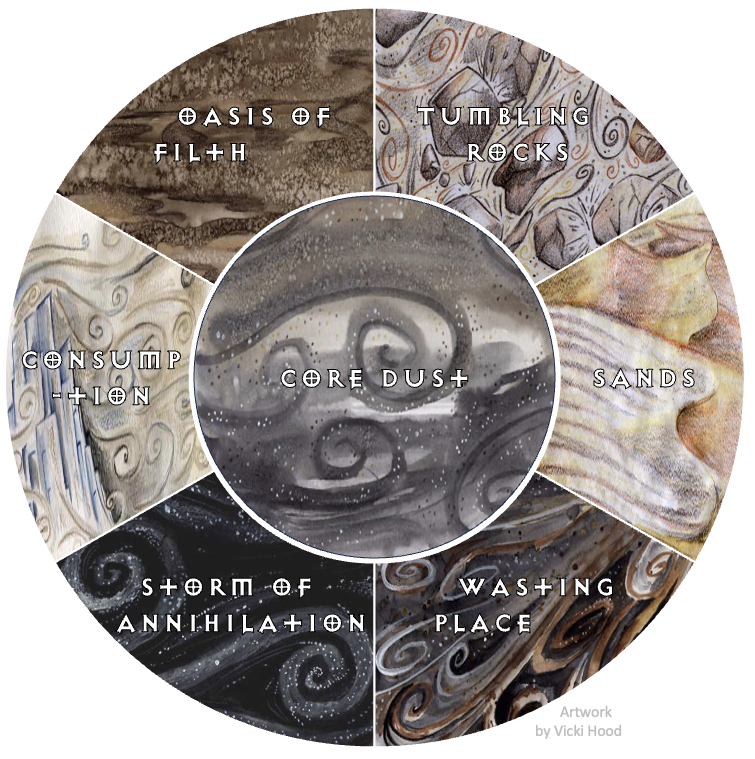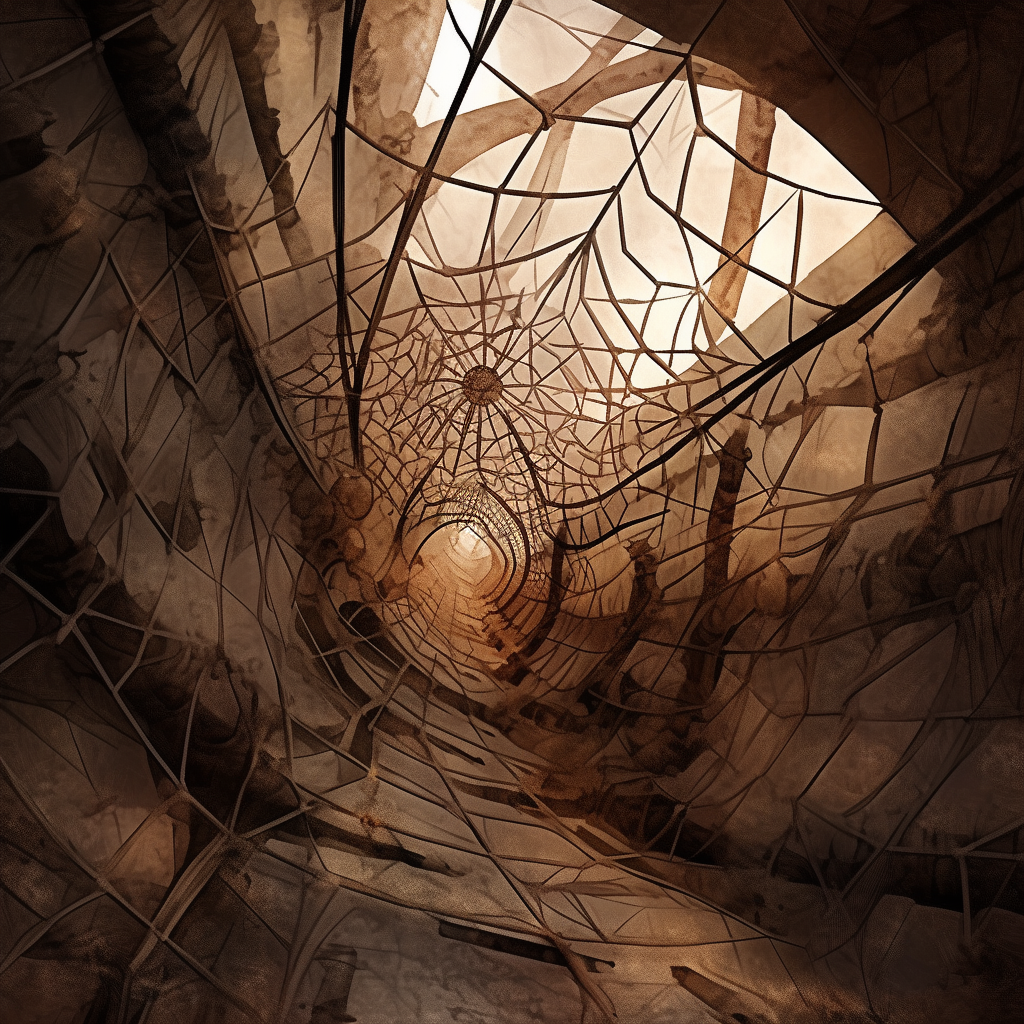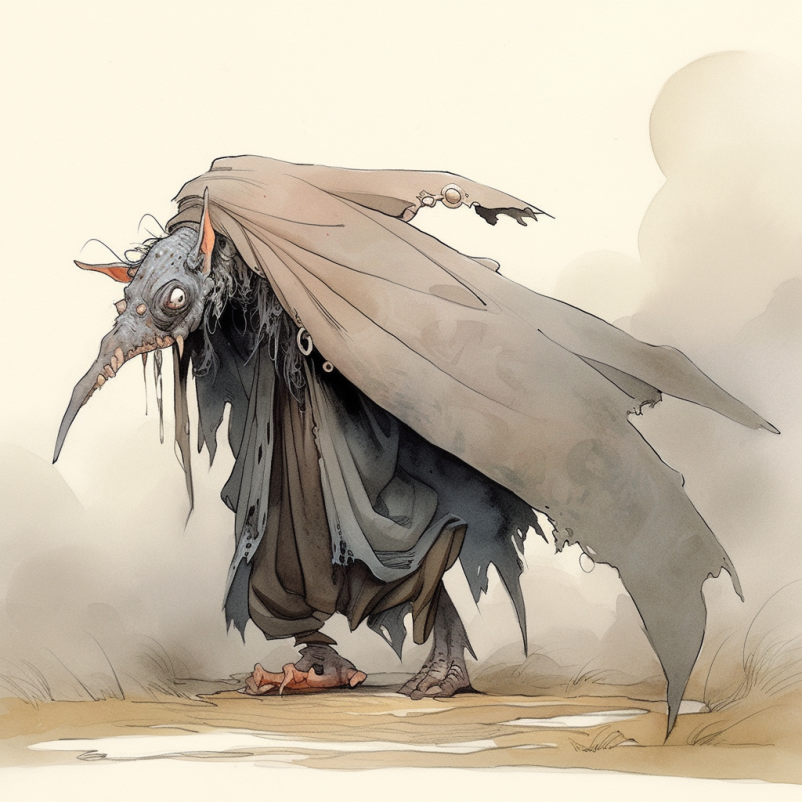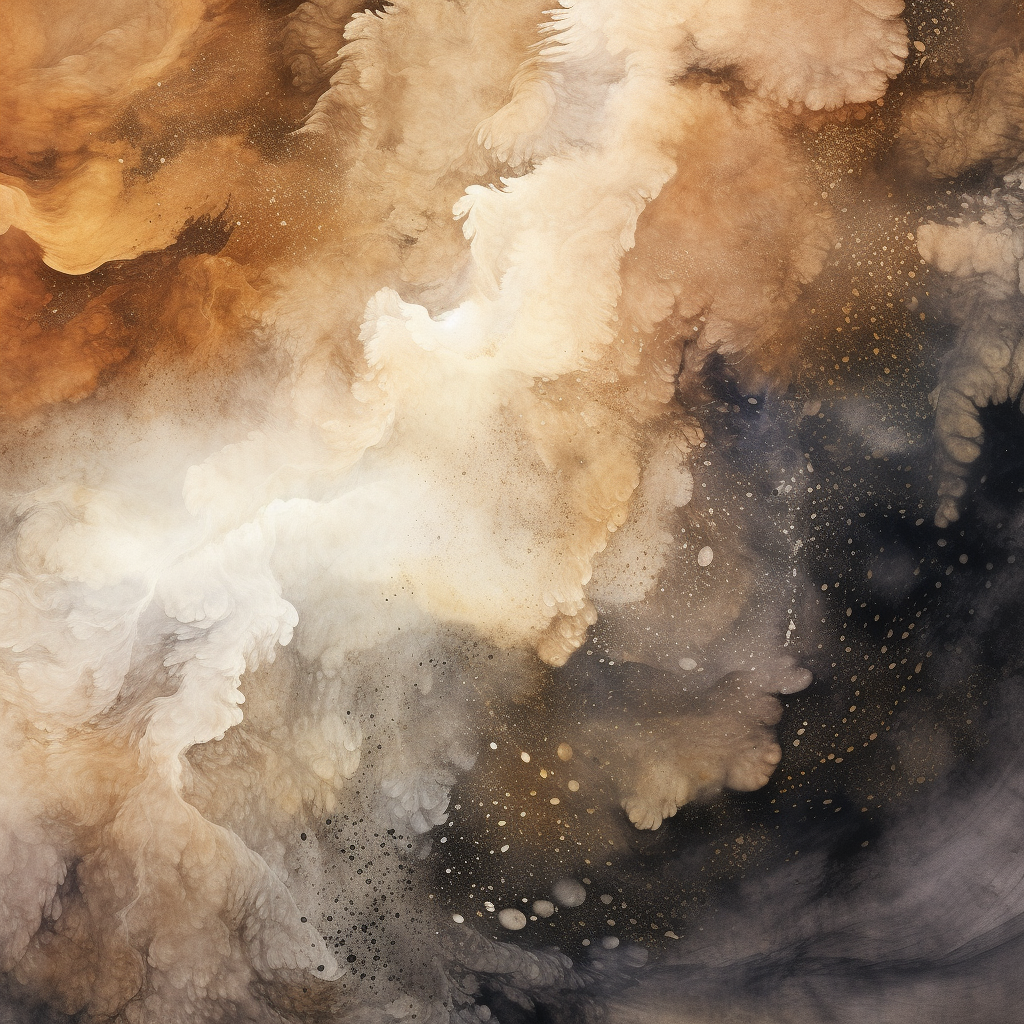The Negative Quasi-Elemental Plane of Dust
Touring the Fallapart
Crumbling, Portalskippers! (That’s a Dust greeting, if you hadn’t guessed). Yes, it’s your old and cold mate Efka again… Voila! just jinkled me to tell you some of the whispers on the plane of Dead Stones, the place the legends have it that rocks and boulders go to when they’re just too tired to carry on being so solid. It’s hard work being hard, you know…

Ah, Dust and Sand. Silt and Grit. Glorious fragments of the most solid stuff. You know, some primes reckon that creatures from Dust slip into their reality at night and sprinkle dust into their eyes. What a lot of barkle, portalskippers! What self-respecting quasi-elemental creature would journey to another plane and willingly leave elemental material from its home behind? No skippers, the real reason for sleeping dust is that the borders between the Negative Quasiplane and the Prime are decaying as the plane itself crumbles.
If you leave a room without cleaning it, dust builds up, right? That’s because tiny holes between the planes let through the smallest fragments of dust and grit, see… to keep a place free of dust is a constant battle against the insidious element. Some wisebeards reckon that your prime deserts are places where the barriers grew so weak that they split asunder, allowing miles and miles of elemental material through before they reformed again (or those meddling aeons fixed things). Some even say that at the heart of great deserts still lie vortices to Dust, activated by sandstorms and the like. In any case, many’s the cutter who’s obsessively cleaned their house hoping that this would prevent a similar fate!
So what is there in the plane of Dust? Apart from the obvious (and frankly dull) endless expanses of quasielemental material, the plane has more than its share of ruins. Some chivs theorise a building that’s given up the ghost and decided it’s time to pass away can eventually end up here; as the bricks and mortar crumble away on the prime and the wind blows away the dust, the particles somehow end up here and continue the dying process. Only ruins that ended that way through neglect and natural wastage can make the trip, and it’s certainly one way… buildings razed to the ground likewise can appear in Ash.
Greetings Duster. Call me Farstrider Efka,
—Farstrider Efka
yes, none of this new fangled “Planewalker” with me,
I go by what the Old Gods intended us explorers to be called

The Crumbs of Reality: Physical Conditions on Dust
Crumbled earth, enervated through the negative. Dare I say, this is the doom of earth itself. I hope you brought facial protection or your sneezing will never cease. The same effects that crumble earth can risk crumbling you. It’s best to ready protection, lest you too become dust.
So here’s a glancing look at the plane, its physical conditions, and vital chant you’ll need to know if planning to come here. The plane of Dust has no layers. Fact is, cutter, some graybeards in Spiretown don’t even think it’s a real plane at all, they mumble something about negative energy causing entropy to elemental earth, crumbling and disintegrating it to dust, creating elemental chaos or some such barkle. All I can say to them is that unlike books and so-called sages, the vast swathes of dust don’t lie — this barmy place is real enough when you’re picking grit from your teeth and the sand from, well, everywhere else. Oh no cutter, just because I’m undead don’t mean I don’t hate it when the sand gets everywhere.
At its edges, Core Dust touches Earth, Magma, Ooze, Salt, Ash and the Negative. As you move towards any of those other elements, the nature of the dust itself changes…
Mapping Infinity: The Fallapart

- Core Dust is the disintegrating heart of the plane.
- Travel Saltwards and you’ll come across the desiccated husk of Consumption.
- Head Oozewise and the dust becomes thicker and slimier as you enter the despicable Oasis of Filth.
- Towards Earth, you’ll find the Tumbling Rocks, the edge of solidity.
- Towards Magma, the Dust becomes sharper and more grainy until it becomes the Sands.
- Head Ashwards and the dust becomes colder, grayer and flakier as you enter the Wasting Place.
- And then finally, if you dare, venture Nothingwards and let the decay set in as you give up the last vestiges of anything solid in the Storm of Annihilation.
Atishoo, Atishoo, We All Fall Down
What would you expect from a plane of fragments, cutter, but a scattering of chants, darks which once possibly fit together but are now so disjointed they look like they have nothing in common? Dust is like this—the nature of the plane wears away at Truths until they’re vague, takes strong bonds and makes them weak, distances siblings and friendships, and fragments stuff.
I make no apologies, then, for the chant this mimir holds on Dust. Get used to it, berk, because that’s what the plane’s like. Make sense of the pieces you can. If two darks seem to fit together, then maybe they once did, but the edges are so nebulous you’ll find it hard to spot where one ends and the lies begin…
Places of Note

- Ashes of Penance (site in the Wasting Place)
- Burning Rocks, the (site in the Sands)
- Castle Staubenfest (site in the Tumbling Rocks)
- Cathedral of Cobwebs, the (site and burg in Core Dust)
- Choking Cloud, the (hazard in the Wasting Place)
- Citadel Alluvius (site in the Storm of Annihilation)
- Cosmic Dust (realm in the Storm of Annihilation)
- Doomglory (realm in Core Dust)
- Dreaming’s End (realm in the Tumbling Rocks)
- Drum Murti (site in Core Dust)
- Dust of Creation (realm in the Oasis of Filth)
- Dust to Dust (burg in Core Dust)
- Everything Crumbles (realm in the Oasis of Filth)
- Footprints in the Dust (site in Consumption)
- Great Vortex, the (hazard in Core Dust)
- Ilkmar (burg in Consumption)
- Library of Dust (site in Consumption)
- Mote (burg in the Storm of Annihilation)
- Palace of Obliteration (realm in the Oasis of Filth)
- Rock of Eternity (site in the Sands)
- Sand Mines, the (site in the Sands)
- Shadowdust (site in the Wasting Place)
- Sirocco (burg in the Wasting Place)
- Smoke Powder (burg in the Sands)
- Thanat-am-Suel (burg in the Tumbling Rocks)
- Tower of Babel (site in Core Dust)
- Udornim’s Tower (site in the Storm of Annihilation)
Philosophy and Culture
- Doomguard (see also Citadel Alluvius)
- Heralds of Dust (see Dust to Dust)
- Opposition (sect from PSMC3 p66) [more details]
- Primals (sect from PSMC3 p74) [more details]
Movers and Shakers

- Alu-Akkad (demipower of disintegration of social institutions)
- Alu Kahn Sang (primordial of Dust)
- Anzu (demipower of broken dreams)
- Calistra (vortex researcher)
- Doomlord Pereid (Citadel Alluvius)
- Dustbowl God (demipower of all happenings)
- The Dust Tyrant (a minor beholder power)
- The Dust Seller (planewalking merchant)
- Odaiel, the Dust of Creation (power of creation and destruction)
- Paradyn (demipower of abandoning ideals)
- Scintner (dao exile)
Hazards of Dust
- Choking Cloud
- Cobwebs (Inner Planes [2e] p116)
- Dust Devils (Inner Planes [2e] p116)
- Negative Pockets (Inner Planes [2e] p116)
- Smoke Powder
Natives of Dust

New creatures on mimir.net
- Aeshar
- Fauna of Dust
- Khirth (PSMC3 p123)
- Tabbitbug (PSMC3 p123)
- Verd (PSMC3 123)
- Genasi, Dust
- Koylith
- Ragfolk
- Valkarthi
Other Creatures of the Dust
- Animental (PSMC3 p14) [2e stats]
- Bulette (MM 33) [2e stats] [3.5e] [5e] [PF1e] [PF2e]
- Chososion (PSMC3 p26) [2e stats]
- Dragon, Brown (MM 80) [2e stats]
- Dune Stalker (MC14 Fiend Folio) [2e stats] [5e]
- Entrope (PSMC3 p38) [2e stats]
- Fundamental (PSMC3 p46) [2e stats]
- Hakeashar [2e stats]
- Hatori (MM p185) [2e stats]
- Genie, Dao (MM p126) [2e stats] [PF1e, see genie, shaitan] [PF2e]
- Giant, Desert [2e stats] [PF1e] [PF2e]
- Mephit, Dust (PSMC) [2e stats] [3.5e] [5e] [PF1e] [PF2e]
- Meenlock [2e stats]
- Menglis (PSMC3 p60) [2e stats]
- Mimic, Dune [5e stats]
- Opposition explorers (PSMC3 p66) [more details]
- Primal procession (PSMC3 p74) [more details]
- Quasielemental, Dust (PSMC3 p78) [2e stats]
- Remorhaz [2e stats] [3.5e] [5e] [PF1e] [PF2e]
- Rust Monster (MM 305) [2e stats] [3.5e] [5e] [PF1e] [PF2e]
- Ruvoka, Gobinhu (PSMC3 p90) [2e stats]
- Sandling (MM 102) [2e stats] [5e] [PF1e]
- Sandman (MC Annual 4) [2e stats] [5e or 5e] [PF1e]
- Skriaxit [2e stats and here]
- Weird, Silt (Polyhedron #80) [2e stats here]
- Web, Living (MCA3 p117) [2e stats]
- Wight, Dust (MM3 p47) [here]
- Worm, Lukhorn (MC Annual 4, p91) [2e stats]
- Worm, Purple (MM 364) [2e stats] [3.5e] [5e] [PF1e] [PF2e]
- Xorn (MM) [2e stats] [PF1e] [PF2e]

The Sky and Ground
The Sky and Ground — Like Ash, Dust is a solid plane, if you don’t mind using the word ‘solid’ in a pretty loose sense. With a consistency of wet sand at its most solid (with the occasional lump of rock thrown in) to clouds of dusty nothing at its thinnest, there’s no division between sky and ground. In places, a traveller can simple walk through the plane, in others she’ll have to dig. Careful, though, because tunnelling here is treacherous and cave-ins frequent.
The Light
If you like a bit of light, you’ll have to bring your own. The proximity of Dust to the Negative means that light sources are dimmer than you’d expect, but as you can’t see far anyway, it’s not like it matters. Either the plane is solid or so choked with dust that vision is measures in inches rather than yards!
The Air
You’ll need to create your own air in the majority of the plane, or just learn to breathe dust. There are plenty of air pockets in caverns and tunnels however, which is where most of the non-elementals tend to congregate. Whether it’s the natural air pockets or your own magical air though, you’ll probably want to wear a face mask and nose filters though, because the sandy stuff gets everywhere. Much easier if you just give up on the breathing altogether like me.
The Gravity
Bring your own. Or rather, think your own. The plane has no up or down of its own, so if you like that sort of thing (as most planewalkers do) be prepared to spend some time imagining it up.
The Hazards
The Storm of Annihilation disintegrates whatever it can. If a creature dies in the Storm, they are reduced to a pile of fine gray dust. If a non-magical object is left unattended for at least a week, it gradually decays into gray dust as well.
The Laws
Little is taboo on this plane, for the pervasive nature of death and decay here preclude most of the things societies regard as abhorrent crimes from being any more than the norm on Dust. Someone’s been murdered? Who cares? They were on their way out anyway. However, one thing should be noted. Priests who use spells in the sphere of Creation should beware for the spirits and powers of the plane take great exception to these magics. Similarly, the casting of the wizard spell mending is a heinous crime.
The Magic
Some spell keys here revolve around the crumbling of stones. If your spell requires crushed sandstone for a key all well and good. But mages who like to cast higher-level spells had better work on their finger muscles, for crushed flint and diamonds are tall orders for anyone! Other keys take the form of quiet, whispered lamentations. These breathless calls hold a special power, enabling magic to work normally here.
I’ve also got the chant on a handful of spells that are well-known here but maybe haven’t made it to Spiretown:
- Irritating Dust (level 1 wizard spell)
- Dust Missile (level 2 priest spell)
- Dusty Trail (level 2 wizard spell)
- Dust Blind (level 3 wizard spell)
- Dusting (level 3 wizard spell)
- Traces in the Dust (level 3 wizard spell)
- Dust Cloud (level 4 wizard spell)
- Quicksand (level 6 wizard spell)
- Tendrils of Dust (level 9 wizard spell)
Wondrous Items of Dust
- Magical Dusts
- Atramen Oil, Atramen Fruit [3e] Planar Handbook p75
The Locals
The Elemental-Kin
‘Bleak’ is a word that readily springs to mind when considering the natives of Dust. The mephits tend to be a dour bunch, obsessed with death and decay—they’d make fine members of the Doomguard or the Dead if they weren’t so sodding provincial and apathetic that they’d considered there’s life outside this miserable plane. The quasi-elementals are similarly unfriendly, though this is more due to their longevity. Dust quasielementals are about as immortal as they come, and they delight in watching things slowly crumble. The chant goes a dust quasielemental thinks nothing of spending several centuries on the Prime watching a rock become weathered, crack and blow away. You can imagine they’re not the greatest of conversationalists.
The Restless Dead
Dust Wraiths are wraiths, who along with spectres, wights, slow shadows, nightshades, etc. roam the borders of Dust and the Bottom of the Multiverse, dipping in and out of the Storm of Annihilation on either side.
The short. single-minded and violent lives of mortals gives rise to many ghosts and ethereal undead. These unresting souls exist continually on their Prime world until the world ages, decays, and dies. Some dead Prime worlds turn to dust, and as the memory of those worlds fades, they join the plane of Dust. However, the undead beings without physical form continue to exist, oblivious of their environment. They take on dusty bodies here, forever un-living their non-life, and gather in the empty places of the place, particularly the Storm of Annihilation bordering the Negative.

Canonical Sources:
- The Inner Planes [2e] p124-117 (Essential information for would-be travellers)
- Planescape Monstrous Compendium Volume III (various dusty beasts)
- Manual of the Planes [5e] p126-128, see here
Sources: Rip van Wormer, Monte Lin and Jon Winter-Holt


